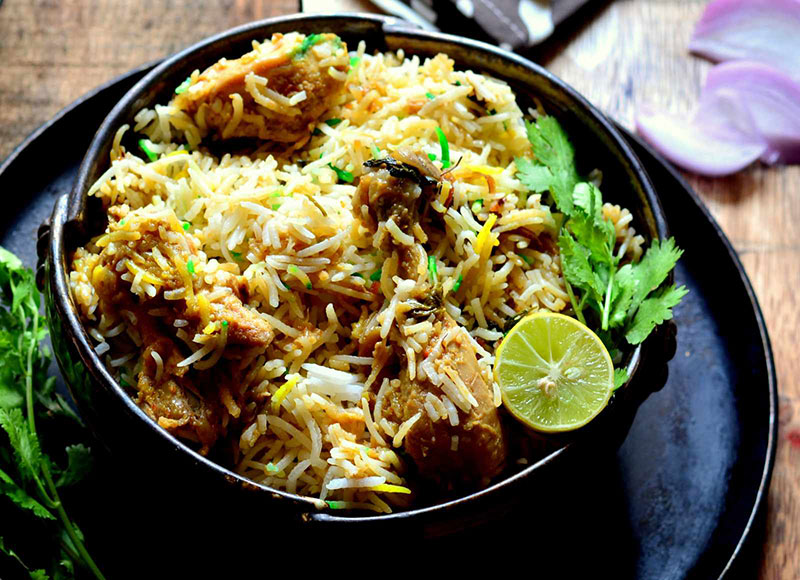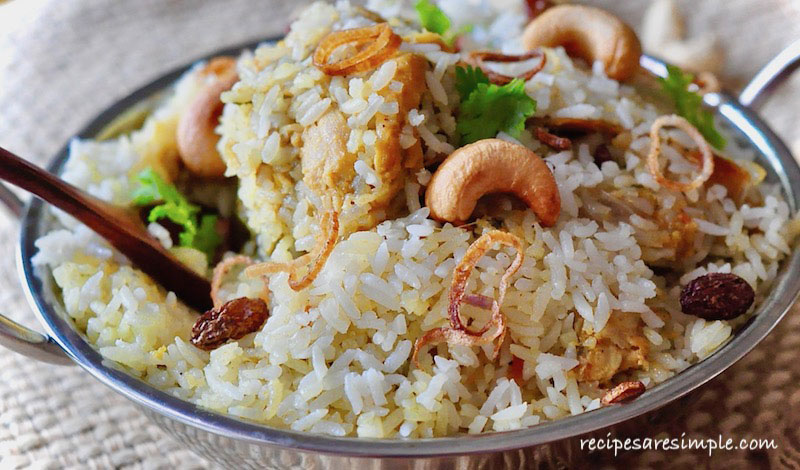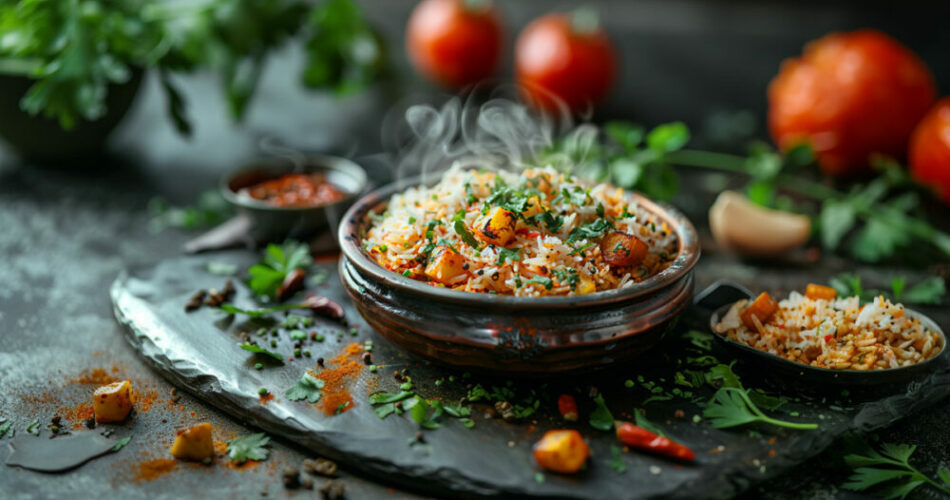Imagine unearthing a treasure chest, not of gold, but of spices and flavors, with each bite beckoning a bygone era of royal kitchens and aromatic alleyways. Biryani recipes aren’t just meals; they’re a voyage through rich tapestries of Indian culture, infused in every grain of spiced basmati rice.
My journey through the art of Mughlai cuisine has led me to master the layers of this iconic dish, and it’s a chronicle I’m eager to share.
This article unfolds the secrets to crafting the perfect biryani, from the marriage of yogurt-marinated meats to the subtle infusion of saffron strands, all nestled within a bed of fragrant rice that dances with biryani masala.
Through tantalizing Hyderabadi and hearty Lucknowi styles, I will guide your senses into the heart of biryani’s culinary grandeur.
You’ll discover the traditional biryani preparations that have been the centerpiece of gatherings for centuries. With my 15 years simmering pots of this storied dish, you’ll learn to recreate the vibrant essence of biryani in your own kitchen, garnishing your culinary reputation with every layer.
Biryani Recipes
| Biryani Style | Base Ingredients | Key Spices/Flavors | Meat typically used | Distinguishing Feature |
|---|---|---|---|---|
| Hyderabadi Biryani | Rice, Meat, Yogurt, Saffron | Cardamom, Cinnamon, Cloves, Mace, Nutmeg | Goat or Chicken | Layered and cooked in a sealed pot (Dum style); Spicy and Aromatic |
| Lucknowi Biryani | Rice, Meat, Yogurt, Saffron | Saffron, Star Anise, Mace, Green Cardamom | Goat or Chicken | Mild in spice; Flavors imparted through the use of aromatic spices and perfumes |
| Kolkata Biryani | Rice, Meat, Potatoes, Eggs | Nutmeg, Cinnamon, Mace, Cardamom | Chicken or Mutton | Characterized by the presence of soft-boiled potatoes and eggs |
| Malabar Biryani | Rice, Chicken or Fish, Cashews | Fennel, Cinnamon, Cloves, Tamrind | Chicken or Fish | Coastal flavors with a hint of tang from tamarind or lemon juice |
| Sindhi Biryani | Rice, Meat, Yogurt, Potatoes | Sour yogurt, Chilies, Coriander, Mint | Beef, Mutton or Chicken | Tangy and spicy with generous use of fried onions and chilies |
| Bombay Biryani | Rice, Chicken or Mutton, Plums | Dried plums, Fried onions, Spices | Chicken or Mutton | Sweet and tangy notes from plums amidst spicy and rich flavors |
| Delhi Biryani | Rice, Meat, Yogurt | Black Cumin, Aromatic Spices, Fresh Coriander | Goat, Chicken or Beef | Mildly spiced with a balance of spices and fragrance |
| Memoni Biryani | Rice, Meat, Yogurt | Green Chilies, Black Pepper, Cumin | Mutton | Very spicy and oily with lesser tomatoes compared to Sindhi Biryani |
| Ambur Biryani | Rice, Meat, Curd | Star anise, Cinnamon, Cloves | Chicken or Mutton | Meat marinated with curd and spices, known for its slightly tangy flavor |
| Thalassery Biryani | Rice, Chicken, Ghee, Nuts | Fennel, Cumin, Star Anise, Coriander | Chicken | Use of aromatic Khaima/Jeerakasala rice and fried onions with cashews |
Hyderabadi Biryani

Hyderabadi Biryani is a regal dish steeped in the history of Indian royalty. A heady concoction of marinated meat and basmati rice, it requires precise layering and is often cooked using the dum method, trapping flavours within. The result is a spicy, fragrant feast, adorned with caramelized onions, mint, and saffron.
What we like about it: Its strength lies in the powerful blend of spices and the slow-cooked, tender meat that is absolutely divine.
Lucknowi Biryani (Awadhi Biryani)

Image source: Archana’s Kitchen
Lucknowi Biryani, often known as Awadhi Biryani, takes on a subtler aroma. Here, the meat is cooked in a yogurt-based marinade, creating a more delicate base. Saffron-infused rice is gently folded into the meat, ensuring a perfectly balanced flavour profile.
What we like about it: The essence of saffron and the sophisticated layering technique make it a favourite among those who savour nuanced flavours.
Kolkata Biryani

Kolkata Biryani’s uniqueness lies in the inclusion of potatoes and boiled eggs. The rice is light, seasoned with nutmeg and cardamom, and less oily, offering a distinct taste profile true to its Bengali roots.
What we like about it: The soft potatoes soaked in biryani spices and the lighter approach to oil and spices set it apart.
Malabar Biryani

Image source: Recipes are simple
Down south, the Malabar Biryani showcases the coastal flavours of Kerala. Generous use of cashew nuts, raisins, and local spices gives it a rich, luxuriant taste, complemented by the distinct tang of kaima rice.
What we like about it: The mingling of coastal spices with sweet accents of raisins and nuts is what makes it a culinary gem.
Sindhi Biryani

Sindhi Biryani is a bold, spicy affair. With its origins in the Sindh province, it uses a liberal amount of chilies and sour yogurt, resulting in a dish that is both zestful and tangy.
What we like about it: The punch of the chilies and the tangy sauce make it resonate with those who crave zest in their meals.
Bombay Biryani

Image source: Masala.tv
The cosmopolitan spirit of Mumbai comes alive in Bombay Biryani. Its distinctive feature is the use of fried and spiced potatoes, a variety of biryani spices, including star anise and black currants, creating a sweet and spicy melody.
What we like about it: The sweet and spicy combination appeals to a broad palate, celebrating the diversity of Mumbai’s culinary culture.
Delhi Biryani

Delhi Biryani is known for its rustic simplicity. It is less spicy, often allowing the flavours of the meats to take center stage. A hint of rose water or screwpine essence adds an aromatic allure.
What we like about it: Its uncomplicated approach focuses on the meat’s natural flavours, augmented by a subtle fragrance.
Memoni Biryani

Image source: Flavored By Fatima
Hailing from the Memoni community, Memoni Biryani is typically spicier and more colourful than most variants. It often features mutton and an array of potent spices, offering an intense kick with every bite.
What we like about it: The rich composition of mutton and potent spices caters perfectly to those with a penchant for intense flavour.
Ambur Biryani

Originating from Tamil Nadu’s Ambur region, this biryani is characterized by its piquant tomato-based rice. Paired often with chicken or mutton, it’s known for the sourness that comes from the tomato and curd mixture.
What we like about it: The tangy twist and its comparatively quicker preparation time make it a unique and convenient choice.
Thalassery Biryani

Image source: Scroll.in
Thalassery Biryani is a culinary jewel from Kerala, made with small-grain Khyma or Jeerakasala rice. The seafood or chicken is deeply infused with Malabar spices, and the rice is cooked with traces of ghee, making it a fragrant and light delight.
What we like about it: It’s the flavours of coastal Kerala on a plate, with every morsel infused with tradition and local ingredients.
FAQ on Biryani Recipes
What’s the key to perfect biryani rice?
A pot of biryani is as soulful as a symphony. The secret? Quality basmati rice. Rinse it well, then soak it, just enough to tease out each grain’s potential. The aim is to achieve that signature separate-grain texture, fragrant and light, laying the ideal foundation for our biryani’s symphonic crescendo of flavors.
How to balance spices in a biryani?
Balancing spices in biryani is akin to painting, where each spice is a color on your palette. Moderation is your friend. A dash of biryani masala, a sprinkle of turmeric, and a pinch of saffron should harmonize, not overpower. Taste as you go—a step crucial to the culinary canvas.
Can I make biryani without a pressure cooker?
Absolutely! In fact, many purists tout the dum biryani method, slow-cooking in a pot sealed with dough. This retains more subtle flavors, imbuing the aromatic biryani with a depth that pressure cooking may miss. Patience rewarded with layers of delicately mingled meats and rice—culinary artistry in a pot.
What are alternatives to meat in a biryani for vegetarians?
Vegetarian biryani is far from an afterthought—it’s a masterpiece. Replace meat with a mélange of vegetables, tofu, or paneer. The key is to maintain rich flavor bases with biryani spices and masala—a testament to the biryani’s versatility, satisfying the palate’s quest for indulgent, spiced elegance.
What’s the difference between Hyderabadi and Lucknowi biryani?
Hyderabadi biryani stands bold and robust, often flaunting more chili, while Lucknowi biryani boasts a subtler, distinctly aromatic demeanor, slow-cooked to coax out delicate undertones. Both dance eloquently on the taste buds, offering regionally inspired takes on the timeless classic.
How long should meat be marinated for biryani?
Marinating meat is a romance, a slow dance marinated in time. Overnight marination weaves a tapestry of flavors deep into every fiber. But if pressed, a minimum of three hours may suffice, letting the yogurt marinade tenderize and infuse the meat with biryani spices for the savory heart of the dish.
What side dishes pair well with biryani?
Biryani is a maestro, yet finds harmony with accompaniments like raita, sliced onions, Mirchi ka Salan, or simply, papad. These sidekicks elevate the meal, offering cool contrasts or added warmth, balancing flavors, and adding textural nuance to the luscious complexity of the biryani.
How to prevent biryani from becoming mushy?
A biryani’s elegance lies in its grainy constitution. To steer clear from muddiness, ensure water ratios are measured with precision and heed cooking times religiously. Treat your biryani as you would a delicate sonnet—each layer, each step, contributing to a poetic end.
Is it possible to make biryani in a rice cooker?
Innovation welcomes all kitchens. While not traditional, the rice cooker is a modern ally. Layer as usual, click ‘cook’, and let the appliance gently cradle your biryani to fruition—convenience meeting heritage in a click. The rice cooker’s consistent heat can still yield a respectable biryani.
How to get the perfect layering in biryani?
Layering in biryani is where the culinary plot thickens. Start with rice, then spiced meat, and alternate. Each tier sprinkled with fried onions, mint, and coriander acts as aromatic bookmarks. The final act—steaming—unites layers into a coherent story, colors deepening, scents interlocking, building to a mouthwatering climax.
Conclusion
Wrapping up our feast of words and flavors, diving into biryani recipes feels like closing a beloved book you wish had no end.
The journey through spiced basmati landscapes, savoring every aromatic whisper of saffron, has been nothing short of magical. Yet, as the lid lifts from the final pot, the true enchantment begins.
In your kitchen, a canvas awaits—a personal touch to every layer, a customized symphony of spices. Remember, beyond techniques and traditional biryani, it’s the love stirred in that creates the dish’s soul.
As you part with these recipes, take with you not just instructions, but inspiration to innovate, to share, and to celebrate life’s rich mosaic—served up one delectable biryani feast at a time.
May your every simmer bring forth a tale as old as time, with you as its ever-crafty raconteur.

